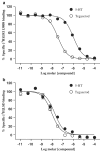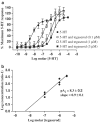The 5-HT4 receptor agonist, tegaserod, is a potent 5-HT2B receptor antagonist in vitro and in vivo
- PMID: 15466450
- PMCID: PMC1575425
- DOI: 10.1038/sj.bjp.0705929
The 5-HT4 receptor agonist, tegaserod, is a potent 5-HT2B receptor antagonist in vitro and in vivo
Abstract
1 Tegaserod (Zelnorm) is a potent 5-hydroxytryptamine4 (5-HT4) receptor agonist with clinical efficacy in disorders associated with reduced gastrointestinal motility and transit. The present study investigated the interaction of tegaserod with 5-HT2 receptors, and compared its potency in this respect to its 5-HT4 receptor agonist activity. 2 Tegaserod had significant binding affinity for human recombinant 5-HT2A, 5-HT2B and 5-HT2C receptors (pKi=7.5, 8.4 and 7.0, respectively). The 5-HT2B receptor-binding affinity of tegaserod was identical to that at human recombinant 5-HT4(c) receptors (mean pKi=8.4) in human embryonic kidney-293 (HEK-293) cells stably transfected with the human 5-HT4(c) receptor. 3 Tegaserod (0.1-3 microm) inhibited 5-HT-mediated contraction of the rat isolated stomach fundus potently (pA2=8.3), consistent with 5-HT(2B) receptor antagonist activity. Tegaserod produced, with similar potency, an elevation of adenosine 3',5' cyclic monophosphate in HEK-293 cells stably transfected with the human 5-HT4(c) receptor (mean pEC50=8.6), as well as 5-HT4) receptor-mediated relaxation of the rat isolated oesophagus (mean pEC50=8.2) and contraction of the guinea-pig isolated colon (mean pEC50=8.3). 4 Following subcutaneous administration, tegaserod (0.3 or 1 mg kg(-1)) inhibited contractions of the stomach fundus in anaesthetized rats in response to intravenous dosing of alpha-methyl 5-HT (0.03 mg kg(-1)) and BW 723C86 (0.3 mg kg(-1)), selective 5-HT2B receptor agonists. At similar doses, tegaserod (1 and 3 mg kg(-1) subcutaneously) evoked a 5-HT4 receptor-mediated increase in colonic transit in conscious guinea-pigs. 5 The data from this study indicate that tegaserod antagonizes 5-HT2B receptors at concentrations similar to those that activate 5-HT4 receptors. It remains to be determined whether this 5-HT2B receptor antagonist activity of tegaserod contributes to its clinical profile.
Figures







References
-
- ABELL T.L., CAMILLERI M., DIMAGNO E.P., HENCH V.S., ZINSMEISTER A.R., MALAGELADA J.R. Long-term efficacy of oral cisapride in symptomatic upper gut dysmotility. Digest. Dis. Sci. 1991;36:616–620. - PubMed
-
- APPEL-DINGEMANSE S., HIRSCHBERG Y., OSBORNE S., POMMIER F., MCLEOD J. Multiple-dose pharmacokinetics confirm no accumulation and dose proportionality of the novel promotile drug tegaserod (HTF 919) Eur. J. Clin. Pharmacol. 2001;56:889–891. - PubMed
-
- BAXTER G.S. Novel discriminatory ligands for 5-HT2B receptors. Behav. Brain Res. 1996;73:149–152. - PubMed
-
- BÉJAR E., MALONE M.H. Inhibitory effect of 5-hydroxytryptamine on rat stomach fundus: mediated indirectly by activation of noradrenaline release. J. Pharm. Pharmacol. 1995;47:637–642. - PubMed
MeSH terms
Substances
LinkOut - more resources
Full Text Sources
Other Literature Sources
Molecular Biology Databases
Miscellaneous

